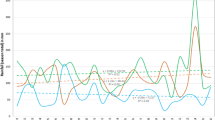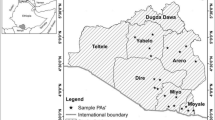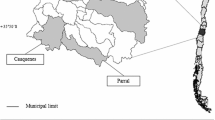Abstract
Climate change poses several challenges worldwide, including the increase in severity and frequency of extreme weather events, such as droughts. As a result, there are projected environmental, economic and social impacts in several sectors, including agriculture. However, the extent of climatic impacts depends on farmers’ awareness and their capacity for adaptation in response to changes in the climate. This study analyzes the factors that influence farmers’ perception of climate change. Data were collected from a farm-household survey in the Rio Grande do Sul state, Brazil. Using a logistic regression model, we identified that farm size, support of extension workers, number of conservation practices adopted, and ecocentrism value influenced positively the perception. Moreover, we found that farm size relied on government actions, subsidies, and anthropocentric value was affected negatively. These findings showed that socioeconomic and psychological factors shape farmers’ perception of climate change. Extension workers and policymakers should increase farmers' awareness on climate change improving the communication on the nature importance for the ecosystem as a whole (ecocentrism) and/or explaining the importance of nature for human welfare (anthropocentrism).
Similar content being viewed by others
Change history
16 March 2021
A Correction to this paper has been published: https://doi.org/10.1007/s10668-020-01108-y
Notes
We considered adoption of crop rotation if the farmer cultivates in summer harvest at least 25% of land size with maize, according to the recommendation of Brazilian Agricultural Research Corporation (Empresa Brasileira de Pesquisa Agropecuária—EMBRAPA 2011).
References
Alam, G. M., Alam, K., & Mushtaq, S. (2017). Climate change perceptions and local adaptation strategies of hazard-prone rural households in Bangladesh. Climate Risk Management, 17, 52–63.
Alauddin, M., & Sarker, M. A. R. (2014). Climate change and farm-level adaptation decisions and strategies in drought-prone and groundwater-depleted areas of Bangladesh: An empirical investigation. Ecological Economics, 106, 204–213.
Apata, T. G., Samuel, K. D., & Adeola, A. O. (2009). Analysis of climate change perception and adaptation among arable food crop farmers in South Western Nigeria. In: International association of agricultural economists’ 2009 conference, Beijing, China. Retrieved February 12, 2019, from https://ageconsearch.umn.edu/bitstream/51365/2/final%20IAAE%20doc.pdf.
Artuzo, F. D., Foguesatto, C. R., de Souza, Â. R. L., & da Silva, L. X. (2018). Gestão de custos na produção de milho e soja. Revista Brasileira de Gestão de Negócios, 20(2), 273–294.
Below, T. B., Mutabazi, K. D., Kirschke, D., Franke, C., Sieber, S., Siebert, R., et al. (2012). Can farmers’ adaptation to climate change be explained by socio-economic household-level variables? Global Environmental Change, 22(1), 223–235.
Bonnot, T. W., Cox, W. A., Thompson, F. R., & Millspaugh, J. J. (2018). Threat of climate change on a songbird population through its impacts on breeding. Nature Climate Change, 8(8), 718.
Buys, L., Miller, E., & van Megen, K. (2012). Conceptualising climate change in rural Australia: Community perceptions, attitudes and (in) actions. Regional Environmental Change, 12(1), 237–248.
Conab. (2018). Séries Históricas das Safras. https://www.conab.gov.br/info-agro/safras/serie-historica-das-safras. Accessed 10 Jan 2019.
da Silva, V. P., & dos França, G. L. D. (2018). Percepções de mudanças do clima, impactos e adaptação para sertanejos do semiárido. Revista Brasileira de Climatologia, 22, 229–248.
de Matteis, A. (2019). Decomposing the anthropogenic causes of climate change. Environment, Development and Sustainability, 21(1), 165–179.
Deressa, T. T., Hassan, R. M., Ringler, C., Alemu, T., & Yesuf, M. (2009). Determinants of farmers’ choice of adaptation methods to climate change in the Nile Basin of Ethiopia. Global Environmental Change, 19, 248–255.
EMBRAPA—Importância da rotação de culturas para a produção agrícola sustentável no Paraná. (2011). Retrieved December 25, 2018, from https://www.embrapa.br/busca-de-publicacoes/-/publicacao/897259/importancia-da-rotacao-de-culturas-para-a-producao-agricola-sustentavel-no-parana.
Fávero, L. P. L., Belfiore, P. P., Silva, F. L. D., & Chan, B. L. (2009). Análise de dados: Modelagem multivariada para tomada de decisões. Rio de Janeiro: Elsevier.
Fochezatto, A., & Grando, M. Z. (2011). Efeitos da estiagem na economia do Rio Grande do Sul: uma abordagem multissetorial. Ensaios FEE, 32(1), 137–160.
Foguesatto, C. R., Artuzo, F. D., Talamini, E., & Machado, J. A. D. (2020). Understanding the divergences between farmer’s perception and meteorological records regarding climate change: A review. Environment, Development and Sustainability, 22(1), 1–16.
Foguesatto, C. R., Borges, J. A. R., & Machado, J. A. D. (2019). Farmers’ typologies regarding environmental values and climate change: Evidence from southern Brazil. Journal of Cleaner Production, 232, 400–407.
Fosu-Mensah, B. Y., Vlek, P. L., & MacCarthy, D. S. (2012). Farmers’ perception and adaptation to climate change: A case study of Sekyedumase district in Ghana. Environment, Development and Sustainability, 14(4), 495–505.
Freitas, P. D., & Landers, J. N. (2014). The transformation of agriculture in Brazil through development and adoption of zero tillage conservation agriculture. International Soil and Water Conservation Research, 2(1), 35–46.
Gross, J. A., & Cassol, R. (2015). Ocorrências de índices de anomalia de chuva negativos no estado do Rio Grande do Sul. Revista Geográfica Acadêmica, 9(2), 21–33.
Hayward, T. (1997). Anthropocentrism: A misunderstood problem. Environmental Values, 6(1), 49–63.
Heath, Y., & Gifford, R. (2006). Free-market ideology and environmental degradation: The case of belief in global climate change. Environment and Behavior, 38(1), 48–71.
Hitayezu, P., Wale, E., & Ortmann, G. (2017). Assessing farmers’ perceptions about climate change: A double-hurdle approach. Climate Risk Management, 17, 123–138.
INMET—Instituto Nacional de Metereologia. (2018). Retreived February 12, 2019, from http://www.inmet.gov.br/portal/.
IPCC—The Intergovernmental Panel on Climate Change. (2012). Managing the risks of extreme events and disasters to advance climate change adoption. Retrieved November 12, 2017, from https://www.ipcc.ch/pdf/special-reports/srex/SREX_Full_Report.pdf.
Ishaya, S., & Abaje, I. B. (2008). Indigenous people’s perception on climate change and adaptation strategies in Jema’a local government area of Kaduna State, Nigeria. Journal of Geography and Regional Planning, 1(8), 138.
Jara-Rojas, R., Bravo-Ureta, B. E., & Díaz, J. (2012). Adoption of water conservation practices: A socioeconomic analysis of small-scale farmers in Central Chile. Agricultural Systems, 110, 54–62.
Kopnina, H., Washington, H., Taylor, B., & Piccolo, J. J. (2018). Anthropocentrism: More than just a misunderstood problem. Journal of Agricultural and Environmental Ethics, 31(1), 109–127.
Mase, A. S., Gramig, B. M., & Prokopy, L. S. (2017). Climate change beliefs, risk perceptions, and adaptation behavior among Midwestern US crop farmers. Climate Risk Management, 15, 8–17.
Mertz, O., Mbow, C., Reenberg, A., & Diouf, A. (2009). Farmers’ perceptions of climate change and agricultural adaptation strategies in rural Sahel. Environmental Management, 43(5), 804–816.
Minteer, B. A., & Manning, R. E. (2005). An appraisal of the critique of anthropocentrism and three lesser known themes in Lynn White’s “The Historical Roots of our Ecologic Crisis”. Organization & Environment, 18(2), 163–176.
Morgan, M. I., Hine, D. W., Bhullar, N., & Loi, N. M. (2015). Landholder adoption of low emission agricultural practices: A profiling approach. Journal of Environmental Psychology, 41, 35–44.
Nedel, A. S., Sausen, T. M., & Saito, S. M. (2010). Zoneamento dos desastres naturais ocorridos no estado do Rio Grande do Sul no período 2003–2009-Parte I. Seca. In XVI Congresso Brasileiro de Meteorologia: Saúde e meio ambiente.
Nobre, C. A., Marengo, J. A., Soares, W. R., & Soares, A. P. (2018). Introduction. In C. A. Nobre, J. A. Marengo, & W. R. Soares (Eds.), Climate change risks in Brazil, Springer International Publishing.
Pires, M. V., Cunha, D. A., Reis, D. I., & Alexandre, B. (2014). Percepção de produtores rurais em relação às mudanças climáticas e estratégias de adaptação no estado de Minas Gerais, Brasil. Revista de Ciências Agrárias, 37(4), 431–440.
Pivoto, D., Barham, B., Waquil, P. D., Foguesatto, C. R., Corte, V. F. D., Zhang, D., et al. (2019). Factors influencing the adoption of smart farming by Brazilian grain farmers. International Food and Agribusiness Management Review, 22(4), 571–588.
Prokopy, L. S., Carlton, J. S., Arbuckle, J. G., Haigh, T., Lemos, M. C., Mase, A. S., et al. (2015). Extension’s role in disseminating information about climate change to agricultural stakeholders in the United States. Climatic Change, 130(2), 261–272.
R Core Team. (2019). R: A language and environment for statistical computing. R Foundation for Statistical Computing, Vienna, Austria. https://www.r-project.org/. Accessed 10 Jan 2019.
Radin, B., & Matzenauer, R. (2016). Uso das informações meteorológicas na agricultura do Rio Grande do Sul. Agrometeoros, 24(1), 41–54.
Roco, L., Engler, A., Bravo-Ureta, B. E., & Jara-Rojas, R. (2015). Farmers’ perception of climate change in mediterranean Chile. Regional Environmental Change, 15(5), 867–879.
Tesfahunegn, G. B., Mekonen, K., & Tekle, A. (2016). Farmers’ perception on causes, indicators and determinants of climate change in northern Ethiopia: Implication for developing adaptation strategies. Applied Geography, 73, 1–12.
Thompson, S. C. G., & Barton, M. A. (1994). Ecocentric and anthropocentric attitudes toward the environment. Journal of Environmental Psychology, 14(2), 149–157.
Twongyirwe, R., Mfitumukiza, D., Barasa, B., Naggayi, B. R., Odongo, H., Nyakato, V., et al. (2019). Perceived effects of drought on household food security in South-western Uganda: Coping responses and determinants. Weather and Climate Extremes, 24, 1–11.
Author information
Authors and Affiliations
Corresponding author
Additional information
Publisher's Note
Springer Nature remains neutral with regard to jurisdictional claims in published maps and institutional affiliations.
Appendices
Appendix 1: Questionnaire

Appendix 2: Correlation matrix of explanatory variables
Variables | Age | Farm size | Extension work | Number of CA | Rely on government | Subsides | Family size | Ecocentrism | Anthropocentrism | Environmental apathy |
|---|---|---|---|---|---|---|---|---|---|---|
Age | 1 | |||||||||
Farm size | − .048 | 1 | ||||||||
Extension work | .170* | − .012 | 1 | |||||||
Number of CA | .020 | − .090 | − .046 | 1 | ||||||
Rely in government | − .179* | .143 | − .120 | .010 | 1 | |||||
Subsides | − .045 | − .059 | .020 | − .164* | .246** | 1 | ||||
Family size | − .179* | .045 | .102 | − .039 | .018 | .074 | 1 | |||
Ecocentrism | .146 | − .066 | .125 | − .053 | .012 | − .047 | .023 | 1 | ||
Anthropocentrism | .028 | .073 | .008 | − .020 | − .087 | − .142 | − .041 | .440** | 1 | |
Environmental apathy | .094 | − .003 | .030 | .033 | − .068 | − .148 | − .101 | − .067 | .284** | 1 |
Rights and permissions
About this article
Cite this article
Foguesatto, C.R., Machado, J.A.D. What shapes farmers’ perception of climate change? A case study of southern Brazil. Environ Dev Sustain 23, 1525–1538 (2021). https://doi.org/10.1007/s10668-020-00634-z
Received:
Accepted:
Published:
Issue Date:
DOI: https://doi.org/10.1007/s10668-020-00634-z







